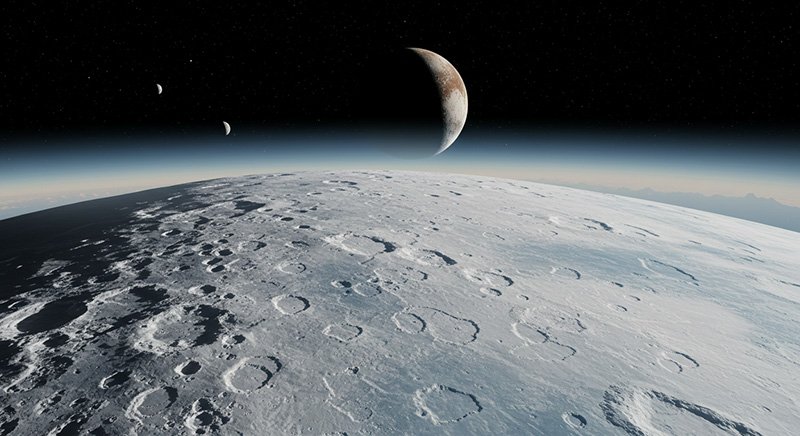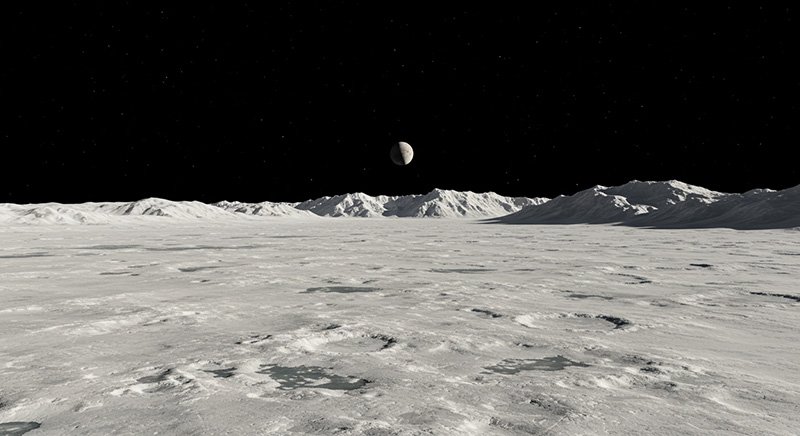Discover how cold it is on Pluto, with average temperatures around -229°C. Explore the icy planet’s extreme climate and NASA’s findings!
Key Takeaways:
- How cold is it on Pluto? Pluto experiences extremely cold temperatures averaging around -229°C (-380°F).
- Surface temperatures range between approximately -218°C (-360°F) and -240°C (-400°F).
- Pluto’s great distance from the Sun, thin atmosphere, and elliptical orbit contribute to its severe coldness.
- Seasonal variations occur due to Pluto’s tilted axis and elliptical orbit, but temperatures remain extremely cold year-round.
- NASA’s New Horizons mission provided detailed insights into Pluto’s climate and surface composition.
When we think about the coldest places in our solar system, our minds often drift to distant worlds far from the Sun. Among these distant celestial bodies, Pluto stands out as one of the coldest, most mysterious places. But exactly how cold is it on Pluto? Let’s dive deeper into Pluto’s climate, exploring why it gets so incredibly cold and what factors influence temperatures on this distant dwarf planet.
How Cold Is It on Pluto? Understanding Pluto’s Extreme Temperatures
Pluto is known for its intense cold, making even Earth’s coldest places seem mild by comparison. According to data from NASA’s New Horizons mission, Pluto has an average temperature of around -229°C (-380°F). But temperatures can vary, ranging from a relatively warmer -218°C (-360°F) to an intense low of -240°C (-400°F).To put this into perspective, the coldest temperature ever recorded on Earth was about -89.2°C (-128.6°F) at Vostok Station in Antarctica. Pluto’s temperatures make this record seem mild by comparison.But why exactly is Pluto so cold? Let’s explore the main reasons behind Pluto’s extreme weather conditions.
Why Is Pluto So Cold? Factors That Influence Pluto’s Temperature

Several factors come into play, making Pluto one of the chilliest places in our solar system. Let’s examine each of these in detail.
1. Pluto’s Great Distance from the Sun
Distance significantly impacts a planet’s temperature. Pluto orbits the Sun at an average distance of approximately 39.5 astronomical units (AU). One astronomical unit equals about 93 million miles—the distance between Earth and the Sun. This means Pluto is nearly 40 times farther from the Sun than Earth is.Because Pluto is so far away, it receives incredibly little sunlight. In fact, the sunlight that reaches Pluto is only about 1/1000th the intensity of sunlight we experience on Earth. This lack of solar energy directly contributes to Pluto’s extremely low temperatures.
2. Thin Atmosphere and Minimal Heat Retention
Another reason Pluto remains extremely cold is its thin atmosphere. Pluto’s atmosphere mainly consists of nitrogen gas, with smaller amounts of methane and carbon monoxide. Because Pluto’s atmosphere is so tenuous, it can’t trap much heat, unlike thicker atmospheres found on planets like Venus or Earth. Most heat Pluto gets from the Sun quickly escapes into space, making the dwarf planet consistently cold.
3. Elliptical Orbit Causes Temperature Fluctuations
Pluto’s orbit around the Sun is highly elliptical, meaning it isn’t a perfect circle. Instead, it varies significantly in distance, ranging from 29.7 AU at its closest to about 49.3 AU at its farthest point. This difference is substantial and results in notable temperature variations throughout Pluto’s orbit.When Pluto moves slightly closer to the Sun, temperatures rise marginally, causing surface ice to sublimate—transform directly from solid to gas—thickening its atmosphere slightly. As it moves further away, this atmosphere begins to freeze and collapses onto the surface. However, even at its closest approach, Pluto remains incredibly cold due to how little solar energy reaches it.
4. Pluto’s Axial Tilt and Seasonal Changes
Pluto’s axis is tilted at an extreme angle, similar to Uranus. This tilt leads to dramatic seasonal changes lasting decades, given Pluto’s long orbital period of roughly 248 Earth years. As Pluto travels around the Sun, different regions experience prolonged periods of darkness or daylight, creating seasonal temperature variations.However, these seasonal changes don’t warm Pluto significantly. Even in its warmest seasons, Pluto’s temperatures remain extremely cold.
Pluto’s Temperature Range | How Cold Does It Really Get?

While Pluto’s temperatures remain consistently low, scientists have measured slight variations at different locations and times. Data from NASA’s New Horizons spacecraft gives us accurate measures of these variations:
- Average temperature: -229°C (-380°F)
- Maximum temperature: around -218°C (-360°F)
- Minimum temperature: approximately -240°C (-400°F)
This range, while relatively narrow, highlights how Pluto’s environment remains incredibly cold, regardless of variations in sunlight exposure or seasonal shifts.
What NASA’s New Horizons Mission Revealed About Pluto’s Cold Climate
NASA’s New Horizons spacecraft provided groundbreaking insights into Pluto’s harsh environment when it flew past the dwarf planet in July 2015. This mission gave scientists unprecedented detail about Pluto’s surface, atmospheric composition, and temperature dynamics.
Surface Composition and Temperature
Pluto’s surface consists mainly of nitrogen ice, mixed with methane and carbon monoxide ice. Nitrogen ice dominates Pluto’s surface—covering over 98% of the planet’s icy plains. The presence of these ices underscores Pluto’s cold temperatures, as nitrogen freezes at approximately -210°C (-346°F). To maintain such abundant nitrogen ice, Pluto’s surface must consistently remain below this temperature threshold.
Atmospheric Observations and Temperature Effects
New Horizons also revealed Pluto’s thin, nitrogen-rich atmosphere, observing how it interacts with surface temperatures. The spacecraft observed haze layers formed by sunlight interacting with atmospheric gases, providing further evidence of Pluto’s unique atmospheric dynamics.Scientists found that Pluto’s atmosphere expands slightly when temperatures rise during its closer approach to the Sun. When Pluto moves further away, this atmosphere condenses and freezes onto the surface in a cycle driven by its extreme cold.
Comparing Pluto’s Cold Climate to Other Celestial Bodies
To better understand just how cold Pluto is, let’s briefly compare its temperatures with other well-known celestial bodies in our solar system.
- Earth: Average temperature is approximately 15°C (59°F), while the coldest recorded temperature is -89.2°C (-128.6°F).
- Mars: Average temperature around -63°C (-81°F), with temperatures dropping as low as -125°C (-195°F) in polar regions.
- Jupiter: Despite its distance, Jupiter’s upper cloud layers average around -145°C (-229°F).
- Neptune: A distant gas giant with average temperatures around -214°C (-353°F).
- Pluto: Average temperature is -229°C (-380°F), colder even than Neptune.
From this comparison, it’s clear Pluto is among the coldest celestial bodies in our solar system, primarily due to its great distance from the Sun and minimal heat retention capabilities.
Why Is Pluto’s Cold Climate Important for Scientific Research?

Studying Pluto’s extreme temperatures helps scientists understand planetary formation and climate dynamics in our solar system. By observing how temperatures affect Pluto’s surface ice and atmosphere, researchers gain insights into the behaviors of icy celestial bodies, both within our solar system and beyond.Moreover, understanding the interplay between Pluto’s orbit, atmosphere, and surface conditions provides invaluable knowledge applicable to studies of other distant objects in the Kuiper Belt and beyond.
Conclusion | Pluto’s Unimaginable Coldness Explained
So, how cold is it on Pluto? In short: extremely cold. With an average temperature of around -229°C (-380°F), Pluto’s coldness results from its great distance from the Sun, thin atmosphere, elliptical orbit, and tilted axis. Although Pluto experiences seasonal variations and temperature fluctuations, it consistently remains one of the coldest places in our solar system.The insights gathered by NASA’s New Horizons mission have significantly enhanced our understanding of Pluto’s weather conditions and surface composition. By comparing Pluto to other celestial bodies, we gain a clearer perspective on the diversity and extremes found within our solar system.Ultimately, exploring Pluto’s extreme coldness not only satisfies human curiosity but also enhances scientific knowledge, helping us better comprehend the universe’s diversity and complexity.
























